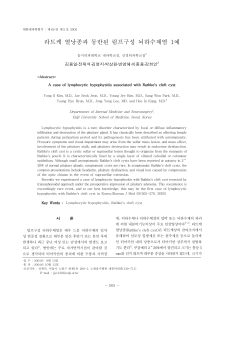
Orbital diploic dermoids
Downloaded from http://bjo.bmj.com/ on December 29, 2014 - Published by group.bmj.com Brit. J. Ophthal. (I674) 58, 105 Orbital diploic dermoids J. F. CULLEN Department of Ophthalmology, Royal Infirmary of Edinburgh Dermoid cysts are relatively common in the region of the orbit and usually occur along the bone suture lines. Periorbital dermoids are frequently encountered at the angles of the orbit and intraorbital dermoids are usually situated outside the muscle cone. Some dermoids, such as those reported below, arise within the diploe of the skull and orbital bones. They expand both inner and outer tables, producing defects therein, and may reach enormous size, as reported by Pfeiffer and Nicholl (I948). Case reports Case I, a 35-year-old housewife, presented because of drooping of the right diplopia of 4 months' duration. upper eyelid and Examination There was fullness of the right upper eyelid, pseudoptosis, and a palpable tender soft tissue swelling towards the lateral aspect of the eyebrow; 4 mm. of exophthalmos were recorded and elevation of the eye was restricted. X-ray examination (Fig. i) A rounded translucent area with clearly demarcated margins was seen within the right frontal bone towards the lateral aspect. FIG. I Case I . X ray of skull, showing outline of dermoid cyst (arrowed) Operation Surgical excision was achieved via a small frontal craniotomy (Mr. J. F. Shaw). The cyst, which measured 2-5 x I -5 cm., was found to be expanding the lateral part of the orbital plate and extending slightly into the main part of the frontal bone. It was covered laterally by thin bone which was absent centrally and its undersurface was attached to the orbital fascia. Received for publication January 15, 1973 Address for reprints: Princess Alexandra Eye Pavilion, Chalmers Street, Edinburgh EH3 9HA Downloaded from http://bjo.bmj.com/ on December 29, 2014 - Published by group.bmj.com io6 J. F. Cullen Case 2, a girl aged 2i years, first attended because of an inflammatory lesion at the outer canthus of the right eye, which was treated with antibiotics. She was seen again 3 months later when crusting and intermittent discharge from the lateral canthus was reported and, furthermore, a similar lesion was now apparent within the hair line in the right temple (Fig. 2). ._ _ ..... . w~~~~~~~~~~~~~~~~~~~~~~~~~~~~~~~~~~~~~~~~~~~~~~~~~~~~~~~~~~~~. ... A~~~~~~~~~~~ ~~~~~~-I4 ~ ~ ~ ~ ~ ~ ~ ~ ~ ~ ~ 0 Sinuses presenting at the outer F IG. 3 Case 2. X ray of skull, showing outline canthus and in the temporal region of cyst (arrowed) X-ray examination (Fig. 3) There was a rounded bony defect with fairly clearly defined margins in the supero-lateral region of the orbit, suggestive of a dermoid cyst. Operation (Mr. J. F. Shaw) A small right fronto-temporal craniotomy was fashioned, the dura covering the frontal lobe was elevated, and a typical dermoid cyst measuring O-5 x I -5 x I cm., lying between the two tables of the orbital plate of the frontal bone, was uncapped. The bone over the cyst having been removed, the cyst was found to be firmly attached to the dura mater covering the supero-lateral aspect of the temporal pole of the brain. This area of dura mater was excised together with the cyst and the sinuses leading to the temple and the lateral canthus. FIG. 2 Case 2. Comment In the cases reported the extent of the cyst was considerably greater than was suggested by either the clinical appearance or the radiological findings. In Case 2 the firm attachment of the cyst to the dura mater necessitated excision of a portion thereof and a dural graft. The unusual presentation of this child, with what was originally diagnosed as an infected granulating tarsal cyst or abscess, is emphasized. The management of cases such as these should not be undertaken by an unwary ophthalmic surgeon, despite the current tendency among ophthalmologists to deal with an increasing variety of orbital conditions. A neurosurgeon is better equipped to deal with these problems. I am indebted to Mr. J. F. Shaw, Consultant Neuro-surgeon, for his assistance in the management of these cases. Reference PFEIFFER, R. L., and NICHOLL, R. J. (1948) Arch. Ophthal. (Chicago), 40, 639 Downloaded from http://bjo.bmj.com/ on December 29, 2014 - Published by group.bmj.com Orbital diploic dermoids. J F Cullen Br J Ophthalmol 1974 58: 105-106 doi: 10.1136/bjo.58.2.105 Updated information and services can be found at: http://bjo.bmj.com/content/58/2/105.citation These include: Email alerting service Receive free email alerts when new articles cite this article. Sign up in the box at the top right corner of the online article. Notes To request permissions go to: http://group.bmj.com/group/rights-licensing/permissions To order reprints go to: http://journals.bmj.com/cgi/reprintform To subscribe to BMJ go to: http://group.bmj.com/subscribe/
© Copyright 2025


















